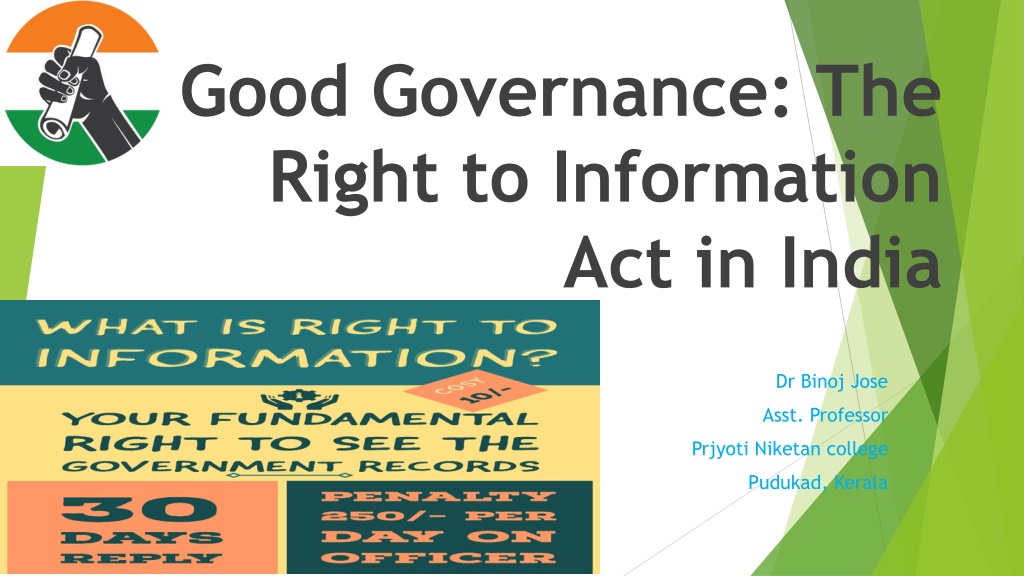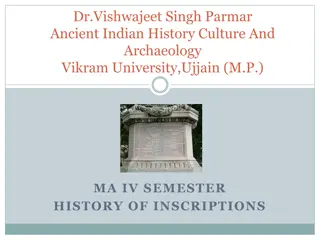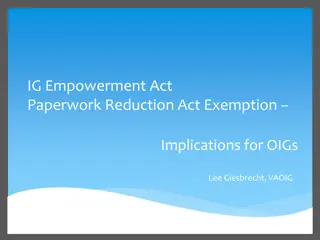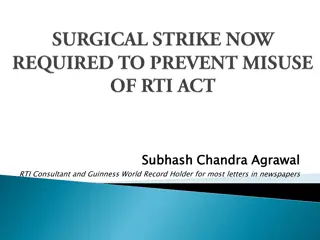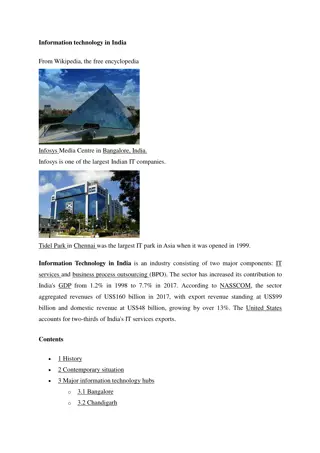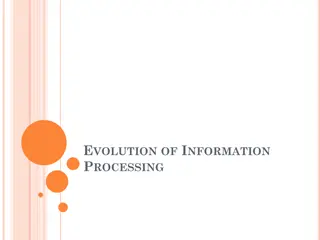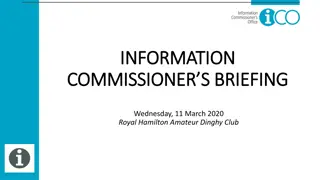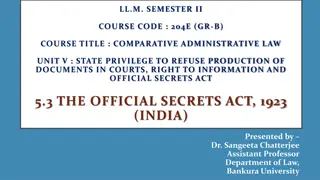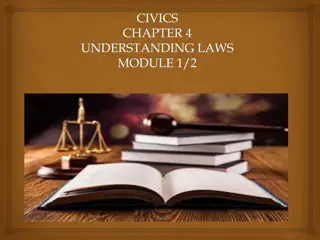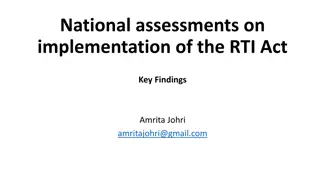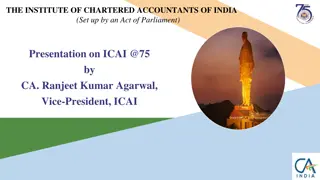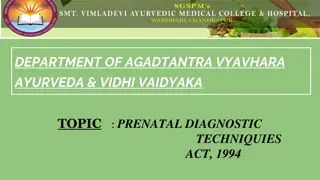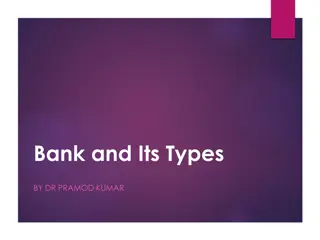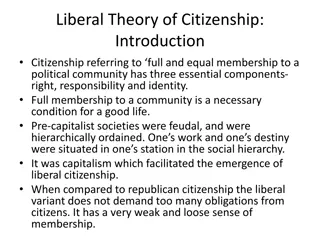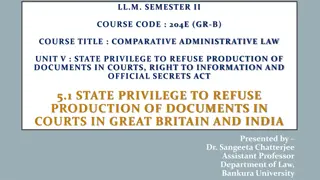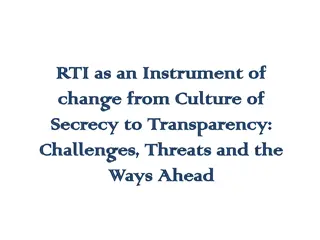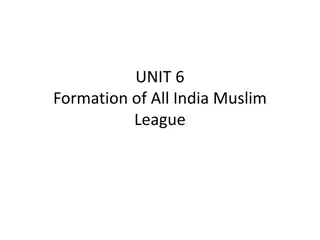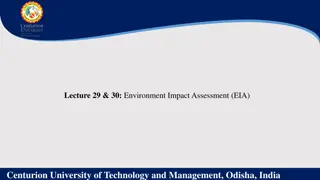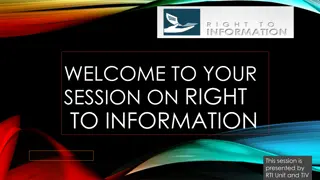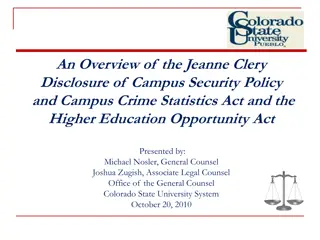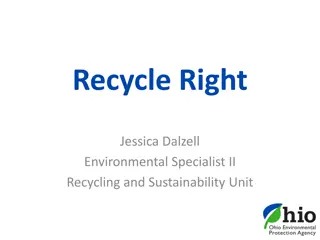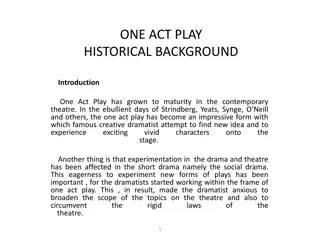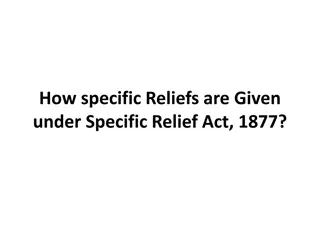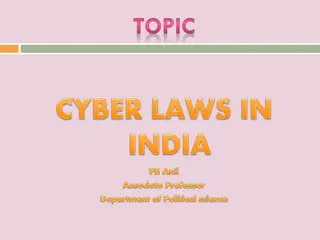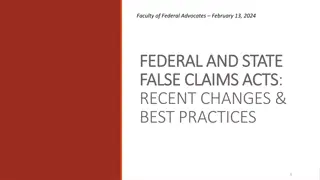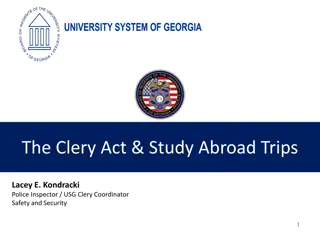Evolution of Right to Information Act in India
The Right to Information Act in India, introduced in 2005, empowers citizens to request government information, promoting transparency and accountability. It is a significant step towards ensuring good governance. The Act originated from the demand for transparency in the 1970s and has evolved from earlier regulations to provide citizens with the right to inspect works, documents, and records.
Download Presentation

Please find below an Image/Link to download the presentation.
The content on the website is provided AS IS for your information and personal use only. It may not be sold, licensed, or shared on other websites without obtaining consent from the author. Download presentation by click this link. If you encounter any issues during the download, it is possible that the publisher has removed the file from their server.
E N D
Presentation Transcript
Good Governance: The Right to Information Act in India Dr Binoj Jose Asst. Professor Prjyoti Niketan college Pudukad, Kerala
Introduction Right to Information Act 2005 mandates timely response to citizen requests for government information. It is an initiative taken by Department of Personnel and Training, Ministry of Personnel, Public Grievances and Pensions to provide a RTI Portal Gateway to the citizens for quick search of information The basic object of the Right to Information Act is to empower the citizens, promote transparency and accountability in the working of the Government, contain corruption, and make our democracy work for the people in real sense. The Act is a big step towards making the citizens informed about the activities of the Government and a very coherent surveillance on the functioning of the government. Under the provisions of the Act, any citizen may request information from a public authority which is required to reply expeditiously or within thirty days. Therefore RTI has vital place in the ensuring of Good Governance
Good Governance The concept of Governance is not new. It is as old as civilization. Simply put GOVERNANCE means: The process of decision making and the process by which decisions are implemented (or not implemented) (India : Kautilya). Good Governance: Efficient, effective, legitimate Good Governance being an adjectival expression, connotes value assumptions Good Governance is associated with efficient and effective administration in a democratic framework. Good Governance refers to adoption of new values of governance to establish greater efficiency, legitimacy and credibility of the system
Evolution of RTI Act in India The Freedom of Information Act 2002 is the predecessor of RTI Act 2005. Infact, prior to RTI Act 2005 and Freedom of Information Act 2002, the public information in India was regulated and restricted by the Official Secret Act 1923. The demand for right to information came up in the 1970 s, in the political campaign Lok Sabha election in 1977. In 1987, a few laborers in Rajasthan were refused their wages on charges of inconsistent performance. Mazdoor Kissan Shakti Sanghatan (MKSS), an activist group fought for these workers and demanded that the government produced the necessary proof to verify the worker s performance records. After a series of protests, the MKSS got the copies of rolls, which also brought to surface the corruption existed among the officials. Provoked by such discrepancies, the MKSS protested for the RTI. This protest turned into a national event leading to the passing of the Freedom of Information Act 2002 which became the RTI Act 2005. A Pune police station received the first RTI application in the year 2005.
Meaning of Right to information inspect works, documents, records. take notes, extracts or certified copies of documents or records. take certified samples of material. obtain information in form of printouts, diskettes, floppies, tapes, video cassettes or in any other electronic mode or through printouts.[S.2) The public authority under the RIT Act is not supposed to create information, or to interpret information; or to solve the problems raised by the applicants; or to furnish replies to hypothetical questions. Only such information can be had under the Act which already exists with the public authority.
Importance of the Right to Information Act This law empowers people to ask for information about central, state governments including non-governmental organizations which are substantially funded by the government. The law gives citizens of India the tools to fight against corruption. RTI gives people the right to hold the government and organizations substantially funded by the government accountable The Right to Information Act gives citizens the right to ask for information and decide, based on the information received, whether their constitutional rights have been met. This law arms individuals with information so that they can advocate for themselves RTI Act helps to: Promote openness, transparency and accountability in the working of every public authority. Reduce Corruption Prevent administrative arbitrariness Bridging the gap between providers and recipient of public services Make citizens part of decision making Make administrative responsive Strengthen the foundations of democracy
RTI Act- Important Provisions Sec. 4 of the Act imposes an obligation on public authorities to maintain its records duly catalogued and indexed in a manner and form which facilitates the right to information under the Act. Sec. 6 of the Act entitles a person desirous of obtaining any information under the Act, to make a request in writing to the Central or State Public Information Officer specifying the particulars of the information sought by him. The applicant is not required to give any reason as to why he is requesting for the information. Sec. 7 of the Act requires the Public Information Officer to either provide the information or reject the request for any of the reasons specified in Secs. 8 and 9 within 30 days of receipt of the request. If the Officer fails to give a decision on the request within 30 days, he shall be deemed to have refused the request. Under Sec. 19, if a person does not receive a decision within 30 days or is aggrieved by a decision of the Public Information Officer, he may prefer an appeal to an Officer who is senior in rank to the Public Information Officer in that Public Authority.
RTI Act- Important Provisions A second appeal is provided for against the order passed in the first appeal before the Central Information Commission or the State Information Commission as the case may be. The powers of the Information Commission are enacted in Sub-Sec. 9 of Sec. 19 which includes the power to require the Public Authority to compensate the complainant for any loss or other detriment suffered and/or to impose any of the penalties provided under the RTI Act. Sec. 20 of the Act empowers the Information Commission to impose penalty on the Public Information Officer if the Commission is of the opinion that the Officer without any reasonable cause refused to receive an application for information or has not furnished the information sought for within the specified time under Sec. 7(1) or mala fidely denied the request for information or knowingly has given incorrect, incomplete or misleading information or destroyed information which was the subject of the request or obstructed in any manner in furnishing the information.
RTI Act- Important Provisions What is the time limit to get information? Thirty days from the date of application. Forty-eight hours for information concerning the life and liberty of an individual An additional five days will be added to the above response time, in case of transfer of application Central Public Information Officer or State Public Information Officer. Failure to provide information within the specified period is deemed as a refusal. What are the penalty provisions? A penalty of Rs.250 up to a maximum of Rs.25,000 will be issued to any Public Information Officer on the following grounds Refusing to receive an application for information Not furnishing information within the specified time Denying request for information in bad faith Destroying information requested Obstructing access to information.
RTI Act- Important Provisions What is the fee? There is an application fee of Rs.10 but it varies from state to state. If further fees are required, the person concerned has to be informed in writing along with calculation details of how the figure was arrived at. No fee will be charged to people living below the poverty line. Applicants can seek review of the decision on fees charged by the PIO by applying to the appropriate Appellate (terms to know) Authority. Applicant must be provided information free of cost if the PIO fails to provide information within the prescribed time limit. Inspection charges of relevant files, documents and records 1. No fee for first hour of inspection. 2. Rs. 5/- for every subsequent hour or fraction thereof. FEES AND CHARGES Photocopy charges of Rs. 2/- per page. If information is required in electronic media floppy/CD, etc additional charges will be applicable
What are covered under RTI Act? The Central RTI Act extends to the whole of India except the State of Jammu and Kashmir. All bodies, which are constituted under the Constitution or under any law or under any Government notification or all bodies, including NGOs, which are owned, controlled or substantially financed by the Government are covered. All private bodies, which are owned, controlled or substantially financed by the Government are directly covered. Others are indirectly covered. That is if a government department can access 1information from any private body under any other Act, the same can be accessed by the citizen under the RTI Act through that government department.
What are Exempted from RTI Act? Exemptions From Disclosure Of Information Sovereignty and Integrity Of India Prevented by courts Breach of privilege of Parliament Trade secret, Intellectual property Fiduciary relationship Information received from foreign Government Life and physical safety of any person Issues under investigation Cabinet papers Invasion in privacy Exempted Organizations IB, RAW of the Cabinet Secretariat DRI, Central Economic Intelligence Bureau Directorate of Enforcement Narcotic Control Bureau Aviation Research Centre, Special Frontier Force, BSF, CRPF, ITBP, CISF, NSG, Assam Rifles, Special Service Bureau Special Branch (CID) Andaman & Nikobar The Crime Branch (CID-CB) Dadra and Nagar Haveli Special Branch, Lakshadweep Police
RTI Officers: The Structure and Mechanism The Central Information Commission The Central Information Commission shall consist of the Chief Information Commissioner (CIC) and such number of Central Information Commissioners not exceeding 10 as may be deemed necessary, appointed by the President of India. Under Section 12(3) of the RTI Act 2005 A committee comprising (i) The Prime Minister, who shall be the Chairperson of the committee; (ii) The Leader of Opposition in the Lok Sabha ; and (iii). A Union Cabinet Minister to be nominated by the Prime Minister, shall select the member of the commission.
RTI Officers: The Structure and Mechanism The State Information Commission The Commission consists of a State Chief Information commissioner and ten State Information Commissioners. They are appointed by the Governor on the recommendation of the committee consisting of the Chief Minister as Chairperson, the Leader of the Opposition in the Legislative Assembly and a state Cabinet Minister nominated by the Chief Minister. They should be person of eminence in public life and should not hold any other office of profit or connected with any political party or carrying on any business or pursuing any profession.
RTI Officers: The Structure and Mechanism Appellate Authority An Appellate Authority is required to look into complaints made by people regarding inability to submit requests to a Central or State Public Information Officer ,denial of access to information, no response to information within the specified time limit, unreasonable fee amount to be paid and any other matter relating to requesting or obtaining access to information A first appeal can be made to a senior ranked Central Public Information Officer or State Public Information Officer within thirty days from the date of expiry or from receipt of decision. Third party appeal against decision made by the Public Information Officer (PIO) must be made within 30 days from date of decision. A second appeal can be made to Central Information Commission or the State Information Commission within ninety days from the date on which the decision should have been made or was actually received. The responsibility of proving denial for request lies with the Public Information Officer who denied the request. An appeal will be disposed of within 30 days from date of receipt or within an extended period of 15 days.
RTI Officers: The Structure and Mechanism Public Information Officer Public Information Officers (PIOs) are to provide information to persons requesting information under this Act. Assistant Public Information Officer provide information to persons requesting information under this Act.
Procedure for Filing RTI Write the application (or get it typed, your choice) on a paper in English/Hindi/the official language of the state. Some states have prescribed format for RTI applications. Address it to the PIO (Public Information Officer) of the department concerned, along with the prescribed application fee Usually Rs. 10 but varies from state to state. The application can be made to the Central Public Information officer, State Public Information Officer, Central Assistant Public Information Officer, or State Assistant Public Officer depending on the case. Ask specific questions. See to it that they are clear and complete, and not confusing whatsoever. Write your full name, contact details and address, where you want the information/response to your RTI be sent. Take a photocopy of the application for your record. If you're sending the application by post, it's advisable to send it via registered post, as then you will have an acknowledgement of your request's delivery. If you're submitting the application to the PIO in person, remember to take an acknowledgement from him/her.
Procedure for Filing RTI The Act is so people-friendly that if an illiterate person approaches a PIO and wants some info under the RTI, he/she can tell his requirement to the PIO and the officer is obliged to write it down for them and read it to them before processing it. One need not write the application on a clean sheet of paper. Even a crumpled, old, torn piece of paper will do, so long as your written content on it is legible. Until the RTI Act empowered the common man to demand information from government, only the members of Parliament had the privilege of seeking this information. If you are hesitant about sending your RTI application by post and can't take a day off work to catch hold of the PIO concerned, you can go to your post office and submit your application to the assistant PIO. The postal department has appointed many APIOs across its many offices. Their job is to receive RTI applications and forward them to the PIO or appellate authority concerned.
CRITICISMS Many departments of Government have appointed more than necessary public information officers (PIOs), which results in difficulty to gain information. Difficulty to people s access to the PIOs. Without security pass people are not allowed to meet the PIOs and at times they are made to wait for hours for security passes. It also has been reported that various ministries and departments of the government are insisting that they will only accept the specific forms that they have designed. The law, however, does not provide for a form or does not authorize the public authorities to prescribe forms. Therefore, whereas they can have recommendatory formats, they must accept all requests even if they are on plain paper. Due to overburdened applications for information, sometimes, wrong information is given out. Sometimes, the authorities fail to respond to the applications even at the expiry of 30 days within which information was supposed to be communicated. The PIO is not given a reasonable opportunity to be heard before penalty is imposed on him.
CONCLUSION Since then, the RTI Act has been used to fight corruption and has exposed deep-rooted graft in India. For example, the RTI applications filed by activists Yogacharya Anandji and Simpreet Singh in 2008 exposed the infamous Adarsh Housing society scam, which eventually led to the resignation of the then Maharashtra chief minister Ashok Chavan. That RTI application revealed that flats in the Adarsh Housing Society. RTI application by Subhash Chandra Agrawal helped to reveal the 2G scam. The RTI Act was also used to expose corruption after the Commonwealth Games scam, in which the corrupt deals by politician Suresh Kalmadi embarrassed the nation. In 2007, the RTI request filed by Krishak Mukti Sangram Samiti, an NGO, revealed irregularities in the distribution of food meant for people living below the poverty line by the public distribution system in Assam.
Conclusion Thus, RTI has helped the people with transparency of the functions of public authorities and expose corruptions. It has reached the people of remote villages too enabling them to seek information on different matters and also to redress their grievances. However, the efficacy of law does not depend on its content but on its proper implementation. Governance has to be an open book and officials should be conscious of the fact that they are liable for omissions and commissions during their tenure for just and systematic work rather than doing things at their whims and fancies arbitrarily and getting away with it after all, the affected people are the country s common masses who bear the brunt of mismanagement. The RTI has to play a critical role in systematic corrections rather than limiting its success to individual cases. Then only the RTI Act can be considered a step towards ensuring a stronger and vibrant democratic process in India.
